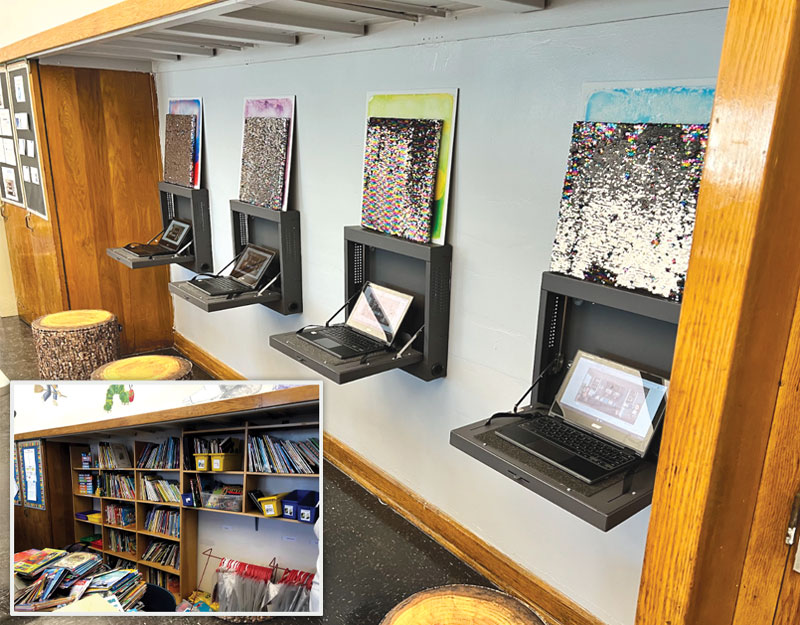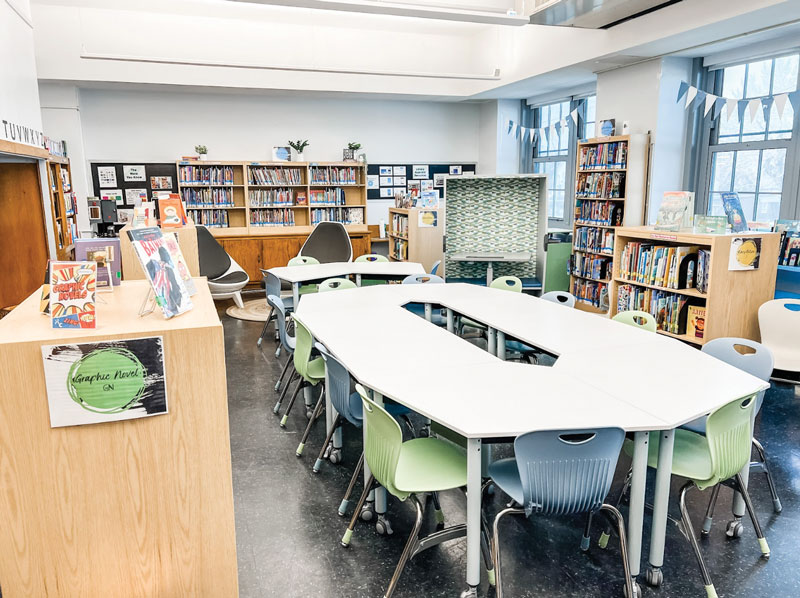New York City's VITAL Program Puts Libraries at the Center of School Communities
The grant program provides funding to revitalize existing school libraries and create a sustainable model for the library to become an essential resource for the school.
 |
P.S. 177 before (inset) the VITAL grant helped recreate the library and after (above and below).Photos courtesy of Brittany Falesto |
The question came randomly to Melissa Jacobs one morning: What makes a library vital?
For the director of library services for the country’s largest school district, New York City public schools, advocating for libraries is always top of mind. But on this morning, Jacobs really dug into this essential question. What interventions would prevent a principal from dismantling a library, from eliminating a library program altogether, she wondered.
“It came down to the school community,” Jacobs says. “If there [was] a community of stakeholders truly invested in the library program, then it becomes something truly essential to the school and is integrated with the experience of students.”
From that idea grew the VITAL Libraries grant program. VITAL—which stands for Vital, Instructional, Transformative, Accessible, Learning—provides a one-time grant of up to $50,000 to existing public school libraries to not only revitalize their space but to create a sustainable model for the library to become an essential resource for their school.
“For a library to be vital, we want them to make sure this is sustainable, and that’s what’s behind the grant and the program,” Jacobs says. “It does come with $50,000 for them. That’s incentive to get the principal on board, but the idea is to build up a sustainable program with stakeholders so it remains a vital part of that school community.”
Funded through support from the Edith & Frances Mulhall Achilles Memorial Fund, VITAL began in 2019 and awarded grants to its first cohort of libraries in 2020. To qualify for a VITAL grant, applicants must have a plan in place to form a Library Advisory Committee (LAC) composed of stakeholders from all corners of a school. That includes the librarian and principal, but also teachers, custodians, students, parents, and all the individuals a school library might serve.
“The LAC is so key to this initiative,” says Patricia Sarles, library coordinator. “Some applicants say they look forward to forming an LAC if they get the grant and we tell them, you don’t need the grant to have an LAC. There’s no reason you shouldn’t have one already.”
With nearly a hundred applications each year, Jacobs has relied on a small team, including Sarles, library coordinator Vincent Hyland, and VITAL program coordinator Geri Ellner Krim, to help her select finalists, conduct site visits, and guide grant winners through the process of developing a vision for their library program, formulating a budget, and organizing their LAC.
Even with the disruption of COVID soon after the program launched, VITAL has so far supported seven different school library programs around New York City.
At the Horan School in East Harlem, the library went from a literal storage room to a bright, welcoming space filled with learning stations and an updated, diverse new book collection. At Curtis High School, a Title I school on Staten Island, librarian Patti Patrissy turned her 100-year-old library into a modern space that would look at home on a college campus.

One of the stars of the VITAL program has been P.S. 177 in Queens. 177 is a District 75 school serving some of the most severe special needs students in the city, and its library was a mess when Brittany Falesto, a special education teacher, inherited it in 2019.
“There was no program,” Falesto recalls. The library was dark and cluttered, not easily accessible for students with moderate to severe disabilities, and its collection was outdated and not age-appropriate for her students.
Despite zero formal training in librarianship, Falesto began to form a plan for the library with the help of Jacobs and the VITAL team.
“I told them the vision my principal and I had,” Falesto says. “I wanted students to have access to the same equitable resources that students in a neurotypical high school have. They should have that same opportunity, and they didn’t have that.”
After receiving one of the first grants, P.S. 177 is now a testament to what the VITAL program can do. Every detail of Falesto’s new library was considered in terms of accessibility. Everything in the library is mobile, from tables to bookshelves, and can be easily rearranged according to the needs of students. The entire collection is also color-coded for ease of use.
In addition to a classroom, the library is also a work site for many students who help with checkout, shelving, and design choices, skills that are built into their occupational therapy (OT) goals.
Jacobs says it might seem minor, “but that the OT is working with the librarian, that it’s written into the IEP, and it’s a job skill that students can take with them and be a productive member of society and possibly getting a job in a public library,” all highlight just how thoughtfully planned the P.S. 177 library is.
Falesto says the VITAL grant has been life-changing. “It got the students to see the potential that could come out of having a space,” she says. “I was able to build my library program because I had the VITAL team supporting me.”
In addition to a new space, P.S. 177 has also gained a full-time librarian. In May, Falesto earned her library credentials through the Teacher 2 Librarian program, an initiative created by Jacobs for classroom teachers to earn a second certificate as a library media specialist over the course of a year.
“VITAL helps give you the money for the infrastructure, but with all of that for me came the path towards librarianship,” Falesto says. “And you can’t have a library without having a librarian.”

But a single librarian can’t sustain a library program alone, so the right committee of stakeholders is an integral part of the plan. Falesto included key members of the school community in her LAC, making sure to invite service providers, including an occupational therapist and a speech teacher. At Erasmus Hall High School in Brooklyn, one of this year’s cohort of VITAL winners, designing an LAC was a much larger endeavor for librarian Debbie Rothfield, who had to include representatives from the five different schools that all share the Erasmus campus and library. Rothfield hopes to add three students from each school to the committee to share what they want from the library.
“For every school, an LAC will look different,” says Krim. “But the important thing is, don’t just invite people into the cheering section. You also want to hear from people who aren’t library users and why you aren’t meeting their needs.”
That mentality helped John Dewey High School librarian Stephanie Rosalia in her planning after receiving a grant as part of VITAL’s most recent cohort. Despite being brand-new to the school when she applied for the grant, Rosalia reached out to as many colleagues as she could, including Robert Butler, coordinator of student activities at Dewey.
“The VITAL community did a good job when we received the grant of presenting to us all the different ways a library can be used through a 21st-century lens,” Butler says. “You imagine a quiet space for study or students doing homework, but at Dewey, where we’re a large school, we’re a hub for South Brooklyn, having the capabilities to do more than that is incredible.”
Together, Rosalia and Butler came up with the idea to use the grant to build both a makerspace and a podcast recording studio. They are also relocating the nonfiction collection to make room for Butler to work out of the library. It’s a calculated move to make sure the library truly becomes the center of the school community.
“If Rob is based in the library, everyone involved in student activities will have to come to the library,” Rosalia says. “There are 35 clubs and that brings in more people and exposes everyone to what we’re doing.”
All told, Rosalia has about 15 people on her committee, including a parent coordinator, assistant principals, custodians, and the school’s robotics teacher. She credits them for winning the VITAL grant. “I have to say, I don’t think the grant was given to me because of my ideas. It was because my team was so strong, and everyone had so much buy-in.”
For Jacobs, that’s exactly the message she’s hoping VITAL will send to other librarians.
“John Dewey came to the table with an organized LAC,” Jacobs says. “Rosalia’s vision was, ‘We’re going to do this, no matter if we get the money.’ For us, what better way to talk about sustainability than moving forward with or without funding?”
Thanks to programs like VITAL and the pipeline of new school librarians created through the Teacher 2 Librarian initiative, NYC schools have reopened libraries for more than 51,000 students across the city. Jacobs and her team are now working on selecting the fourth cohort for VITAL and will also be working on securing a new round of funding to ensure the program can continue for the foreseeable future.
“We’re putting out evidence that libraries are open for students who weren’t there before,” Jacobs says. “A lot of these schools didn’t have library programs prior to us. P.S. 79 and 177 each had something, but not a well-developed library program. Erasmus and Dewey both had just a space, it wasn’t a living, breathing entity. This grant infuses life into it.” n
Andrew Bauld is a freelance writer covering education.
RELATED
The job outlook in 2030: Librarians will be in demand
The job outlook in 2030: Librarians will be in demand
ALREADY A SUBSCRIBER? LOG IN
We are currently offering this content for free. Sign up now to activate your personal profile, where you can save articles for future viewing






Add Comment :-
Be the first reader to comment.
Comment Policy:
Comment should not be empty !!!